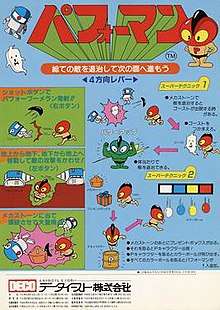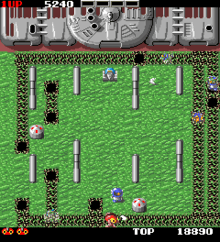Performan
Performan[lower-alpha 1] is an action arcade video game developed by Toaplan and published exclusively in Japan by Data East on April 1985.[3][4] In the game, players assume the role of the titular robot in order to defeat enemies across multiple stages. The title is notable for being created by most of the same team that previously worked on several projects at Orca and Crux before both companies declared bankruptcy in 1984, after which a group of employees from the two gaming divisions would go on to form Toaplan as a result, as well as being one of the few titles by Toaplan that has not received any official port to home consoles as of date.
| Performan | |
|---|---|
 | |
| Developer(s) | Toaplan |
| Publisher(s) | Data East |
| Designer(s) | Kenichi Takano |
| Programmer(s) | Masahiro Yuge |
| Composer(s) | Masahiro Yuge Tatsuya Uemura |
| Platform(s) | Arcade |
| Release | |
| Genre(s) | Action |
| Mode(s) | |
| Cabinet | Upright |
| Arcade system | Toaplan Slap Fight[2] |
| CPU | (2x) Z80[2][3] |
| Sound | (2x) General Instrument AY-3-8910 (@ 2 MHz)[2][3] |
| Display | Raster, 240 x 264 pixels (Vertical), 256 colors |
Gameplay

Performan is an action game reminiscent of Dig Dug in which the players control the on-screen protagonist from a top-down perspective, where the main objective on each screen is to eliminate enemies in order to progress further, while an intermission animation plays between some stages.[5][6] Getting hit by an enemy will result in losing a live and once all lives are lost, the game is over unless the players insert more credits into the arcade machine to continue playing.
The player controls the robot with a four-way joystick and two buttons to attack and dig. Players can dive into the ground to avoid enemies that can also perform the same action to chase the player character.[5][6] Players can also attack enemies by throwing boomerangs, which can trigger the "meca-stones" placed on the playfield to explode and eliminating any enemy caught within its blast radius.[5][6] Players can also trigger the meca-stones under the ground to eliminate enemies as well. Eliminating many enemies at once with an exploding meca-stone grants a determined number of points, which is also crucial for reaching high scores, though players can be paralyzed if the robot is caught with its blast radius. Meca-stones can also be pushed against enemies.[5]
After exploding a meca-stone, a gift item is spawned and after picking up the last gift before completing a stage, a "P" icon appears at the center of the playfield that turns into a colored ball.[5] Collecting four colored balls in a row grants an extra live.[5] After blowing up a meca-stone with enemies nearby, a ghost appears and after catching it, turns the players invincible for a brief time period to defeat enemies.[5][6]
Development and release
Performan was created by most of the same team that previously worked on several projects at Orca and Crux before both companies declared bankruptcy in 1984, after which a group of employees from the two gaming divisions would go on to form Toaplan and among them were composers Masahiro Yuge and Tatsuya Uemura, both of which recounted the project's development process and history between 1990 and 2012 through Japanese publications such as Gamest and Shooting Gameside.[7][8][9][10][11][12] Both Yuge and Uemura stated that the game was designed by Kenichi Takano and that their development environment at the time of the title's creation was done in the bedroom of an apartment.[7][8][9] Uemura worked on the sound design for the game while he still formed part of Crux developing Repulse, however Yuge later assumed the sound design duties after Uemura had a motorcycle accident during development, in addition to programming as well.[7][9][10][11][12]
Performan was released only in arcades across Japan by Data East on April 1985.[3][5] The game ran on a proprietary arcade board manufactured by Toaplan, which used two Zilog Z80 as well as two General Instrument AY-3-8910 chips for sound, while its visuals were rendered at 240 x 264 pixels with 256 colors and displayed 512 sprites on-screen.[2][3][13] The hardware board for the title would be later reused with other titles from the company such as Tiger-Heli, Guardian and Slap Fight.[13] Uemura stated that the reason why the company was not credited for the title was due to contractual arrangements with Data East.[10][11]
Reception
In Japan, Game Machine listed it on their June 1, 1985 issue as being the 20th most-successful table arcade unit of the year, outperforming titles such as Kung-Fu Master and Xevious.[14] Nick Zverloff of Hardcore Gaming 101 gave positive remarks to Performan in regards to the graphics, music and gameplay but criticized several aspects.[6] Den of Geek noted it to be a "fairly low-key" title from Toaplan.[15][16]
References
- Akagi, Masumi (13 October 2006). 東亜プラン (Toa Plan). アーケードTVゲームリスト 国内•海外編 (1971-2005) (in Japanese) (1st ed.). Amusement News Agency. p. 50. ISBN 978-4990251215.
- "Toaplan Slapfight Hardware (Other)". system16.com. Archived from the original on 16 September 2019. Retrieved 8 November 2019.
- "Performan". arcade-history.com. Archived from the original on 20 August 2014. Retrieved 8 November 2019.
- Wovou (2019). "L'histoire de Toaplan". neo-arcadia.com (in French). Neo-Arcadia. Archived from the original on 30 October 2019. Retrieved 8 November 2019.
- Performan arcade flyer (Data East, JP)
- Zverloff, Nick (5 February 2011). "Toaplan Shooters (Page 1) - Performan". Hardcore Gaming 101. Archived from the original on 24 February 2011. Retrieved 15 November 2019.
- "東亜プラン". Gamest (in Japanese). No. 49. Shinseisha. September 1990. (Translation by Shmuplations. Archived 2019-11-07 at the Wayback Machine).
- Iona; VHS; K-HEX (June 2009). "東亜プラン FOREVER (1/5)". Floor 25 (in Japanese). Vol. 9. (Translation by Gamengai. Archived 2011-02-19 at the Wayback Machine).
- Iona; VHS; K-HEX (June 2009). "東亜プラン FOREVER (2/5)". Floor 25 (in Japanese). Vol. 9. (Translation by Gamengai. Archived 2013-02-24 at the Wayback Machine).
- "東亜プラン シューティングクロニクル". SweepRecord (in Japanese). SuperSweep. 14 November 2011. Archived from the original on 21 October 2019. Retrieved 15 February 2020. (Translation by Shmuplations. Archived 2018-07-11 at the Wayback Machine).
- Kiyoshi, Tane; hally (VORC); Yūsaku, Yamamoto (3 February 2012). "東亜プラン特集 - 元・東亜プラン 開発者インタビュー: 上村建也". Shooting Gameside (in Japanese). Vol. 4. Micro Magazine. pp. 33–40. ISBN 978-4896373844. (Translation by Shmuplations. Archived 2019-09-06 at the Wayback Machine).
- Kiyoshi, Tane; hally (VORC); Yūsaku, Yamamoto (3 February 2012). "東亜プラン特集 - 元・東亜プラン 開発者インタビュー: 弓削雅稔". Shooting Gameside (in Japanese). Vol. 4. Micro Magazine. pp. 41–48. ISBN 978-4896373844. (Translation by Shmuplations. Archived 2019-09-06 at the Wayback Machine).
- "Toaplan Hardware - Tiger Heli, Get Star and Slap Fight". The Toaplan Museum. Archived from the original on 17 February 2017. Retrieved 8 November 2019.
- "Game Machine's Best Hit Games 25 - テーブル型TVゲーム機 (Table Videos)". Game Machine (in Japanese). No. 261. Amusement Press, Inc. 1 June 1985. p. 23.
- Lambie, Ryan (24 April 2014). "Why 1985 was a golden year for videogaming". Den of Geek. Dennis Publishing. Retrieved 13 December 2019.
- Lambie, Ryan (21 June 2018). "Toaplan: the rise and fall of Japan's greatest shooting game company". Den of Geek. Dennis Publishing. Archived from the original on 21 June 2018. Retrieved 8 November 2019.
External links
- Performan at GameFAQs
- Performan at Killer List of Videogames
- Performan at The Toaplan Museum
